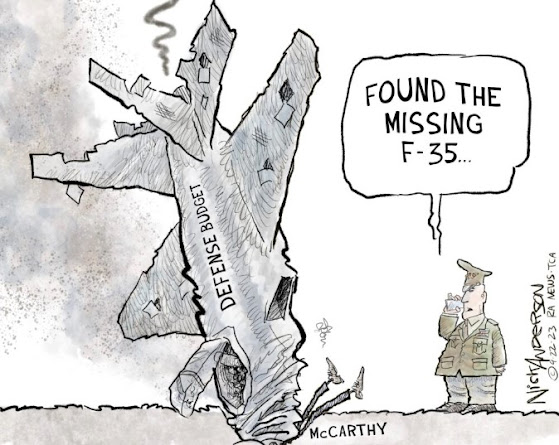As the federal election campaign intensifies, both major parties have unveiled substantial new spending commitments, with the Coalition proposing a multi-billion-dollar investment in additional fighter jets.
The latest announcements have sparked debate over whether these policies represent the most effective use of public funds, with some experts warning that the financial and strategic implications remain unclear.
The Coalition has announced plans to acquire 28 additional F-35 fighter jets from the United States at an estimated cost of $3 billion. The proposal would add to Australia’s existing fleet of more than 70 F-35s, but defence analysts caution that the actual cost of the acquisition—when factoring in maintenance, training, and operational expenses—could be significantly higher, with estimates ranging from $6 billion to $9 billion.
Concerns over the aircraft’s performance and reliability have been raised by independent assessments in the United States. A September 2023 report from the US Government Accountability Office (GAO) found that only 55% of F-35s were operationally capable of fulfilling their missions—well below program targets. Additionally, a December 2023 GAO report highlighted ongoing maintenance challenges, including an overburdened cooling system that has led to increased wear on the aircraft’s engines, contributing to an additional $38 billion in projected maintenance costs over the aircraft’s lifespan.
Manufacturing issues and parts shortages have also led to delivery delays, while software upgrades essential for enhancing the jet’s capabilities have been repeatedly pushed back into the 2030s. In a November 2023 declassified report, further problems were identified, including targeting inaccuracies with the aircraft’s onboard weaponry.
Defence experts suggest that given Australia’s need to significantly expand its defence budget, any future investments should be carefully weighed against strategic priorities and cost-effectiveness. While the Coalition argues that additional F-35s will enhance national security, critics warn that the aircraft’s unresolved technical problems and escalating costs raise questions about whether the funds could be better spent on alternative defence capabilities.
The spending commitments from both parties reflect broader election themes, with the Coalition positioning itself as strong on national security. However, as the campaign progresses, economic pressures—including inflation, budget constraints, and competing policy priorities—are likely to fuel ongoing debate over the feasibility and effectiveness of these high-cost pledges.
With billions in taxpayer dollars at stake, analysts and policymakers continue to call for rigorous assessment of major spending initiatives to ensure that they deliver tangible benefits to Australians, both in national defence.
In the US, the F-35 are strongly criticised with the main concerns being:
- High Costs – The total lifetime cost of the F-35 program is estimated to exceed $1.7 trillion, making it the most expensive weapons program in history. The per-unit cost has decreased over time but remains high when factoring in maintenance and upgrades.
- Maintenance and Readiness Problems – Reports indicate that less than 55% of the US fleet is “mission capable” at any given time, with some aircraft grounded due to parts shortages and repair backlogs.
- Software and Performance Issues – Delays in software upgrades and cooling system failures have led to increased maintenance costs and reliability concerns.
- Weapons and Combat Limitations – Some versions of the F-35 have faced targeting issues, and limitations in dogfighting capabilities have raised concerns in close-range aerial combat scenarios.
Key Companies Involved in Manufacturing the F-35
1. Lockheed Martin (USA) – Prime Contractor
- Leads overall design, integration, and final assembly.
- Manufactures the aircraft's fuselage and key stealth components.
2. Northrop Grumman (USA)
- Builds the center fuselage.
- Provides the AN/APG-81 Active Electronically Scanned Array (AESA) radar and AN/AAQ-37 Distributed Aperture System (DAS), crucial for situational awareness.
- Supplies communication and electronic warfare (EW) systems.
3. BAE Systems (UK)
- Manufactures the aft fuselage, empennage (tail section), and electronic warfare suite.
- Provides ejection seats (via Martin-Baker).
4. Pratt & Whitney (USA) – Engine Manufacturer
- Produces the F135 engine, the sole engine for all F-35 variants.
- Rolls-Royce (UK) contributes to the lift system for the F-35B (short takeoff and vertical landing – STOVL) variant.
5. General Dynamics (USA)
- Supplies various internal and external components, including gun systems (such as the GAU-22/A 25mm cannon).
Key Companies Involved in Weaponizing the F-35
The F-35 is designed to carry a variety of air-to-air, air-to-ground, and standoff weapons produced by several major defense contractors:
1. Lockheed Martin
- AGM-158 JASSM-ER (Joint Air-to-Surface Standoff Missile – Extended Range) – Long-range, precision-strike cruise missile.
- LRASM (Long-Range Anti-Ship Missile) – For maritime strike missions.
2. Raytheon Technologies (USA)
- AIM-120 AMRAAM (Advanced Medium-Range Air-to-Air Missile) – Primary air-to-air missile.
- AIM-9X Sidewinder – Short-range air-to-air missile.
- AGM-154 JSOW (Joint Standoff Weapon) – Air-to-ground guided weapon.
- StormBreaker (formerly Small Diameter Bomb II) – Precision-guided glide bomb for use in all-weather conditions.
3. MBDA (Europe/UK)
- Meteor Air-to-Air Missile – Long-range, beyond-visual-range missile (integrated for European users).
- SPEAR 3 (Select Precision Effects At Range) – A lightweight cruise missile for future integration.
4. Boeing (USA)
- GBU-31/GBU-32 JDAM (Joint Direct Attack Munition) – GPS-guided bomb system.
- SDB I & II (Small Diameter Bombs) – Small, precision-guided bombs.
5. Kongsberg (Norway)
- JSM (Joint Strike Missile) – Anti-ship and land-attack missile designed for internal weapons bays of the F-35.
International Contributions
The F-35 is a multinational program, with parts and subsystems sourced from multiple countries, including:
- Italy (Leonardo) – Builds wings and composite structures.
- Australia (BAE Systems & Quickstep Holdings) – Supplies advanced composite materials.
- Japan (Mitsubishi Heavy Industries) – Produces parts for final assembly in Japan.
- Canada (Meggitt & Magellan Aerospace) – Provides landing gear and engine components.


Comments
Post a Comment